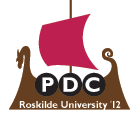| PAPERS | WEDNESDAY 09:00-10:30 | GRAND AUDITORIUM |
Community Facilitation
Session chair: Ina Wagner, Vienna University of Technology
The human touch: Participatory practice and the role of facilitation in designing with communities
Ann Light, Northumbria University
Yoko Akama, RMIT
Abstract. Traditional PD research offers a range of methods for participant engagement. Yet little is shared of the micro-dynamics of participation at its most intense, when the designer as facilitator is challenged by a range of social contingencies. Engaging people in change can be a messy process, especially when emotions run high. This paper explores two situations where communities were asked to collaborate on disaster mitigation plans and looks at how facilitation took place to engage with these concerns. It considers the relationship between method and its enactment, between the participatory practitioner and participant group, and between intention and outcome. In doing so, it questions the prevalent research culture that anonymises facilitation and its agency. Instead, we offer a more synthesised reading of practice, by focusing on aspects that compound the designers’ task, such as the dynamics of the group and emotions manifested by participants. We argue that we need to orientate towards understanding the designers’ participatory practice, rather than reporting participatory methods alone. The act of engaging others involves an embodied knowing, with moment-by-moment shifts in position, focus and delivery. Acknowledging this involves a rethink of our frameworks for reflecting and reporting on design.
Lessons for participatory designers of social media: Long-term user involvement strategies in industry
Mikael Johnson, Aalto University
Sampsa Hyysalo, Aalto University
Abstract. Social media changes the conditions for user participation in service development. Active user communities, fast paced iterative development, considerable development after market launch, developer access to users’ digital trails, peer production, and low cost feature distribution are well known facets that bring substantial changes. In this paper we distil lessons for participatory designers from an in-depth case study of an over decade-long service development in industry, Habbo Hotel by Sulake Corporation. We argue that the range of core issues that shape user participation in social media can be captured by three interrelated issues: 1) shifts in developer–user social distance, 2) cumulated user knowledge beyond one project, and 3) user-generated content and user-owned services. We then consider what insight these provide for a design initiative we are involved in: the Finnish national public service broadcasting company’s teacher resource.
Enhancing cross-cultural participation through creative visual exploration
Kasper Rodil, Aalborg University
Heike Winschiers-Theophilus, Polytechnic of Namibia
Kasper Løvborg, Polytechnic of Namibia
Abstract. Designers, like artists, fuse learned skills with intuition formed over their past experiences to unfold their creativity. Continuous interactions between the designers, their creations, and their informing and receiving environment lead to alignment and harmonisation. However, we observe that displaced designers in an unfamiliar context can no longer blindly rely on their insights only to create acceptable artefacts. In this paper we depict the journey of a young western designer, who accepted the challenge to co-design a 3D graphics visualisation of a small village in Southern Africa. We have observed that the 3D graphics visualisation has significantly increased participation and facilitated co-creation of meaning at the interface of different cultures rather than just being an end product. Not only do we he have to learn to ‘see’ what the village elders see but also experience a paradigm shift in design and evaluation methods. Based on personal interrelations and immanent differing principles the interactions among the participants are renegotiated continuously during the design process.
